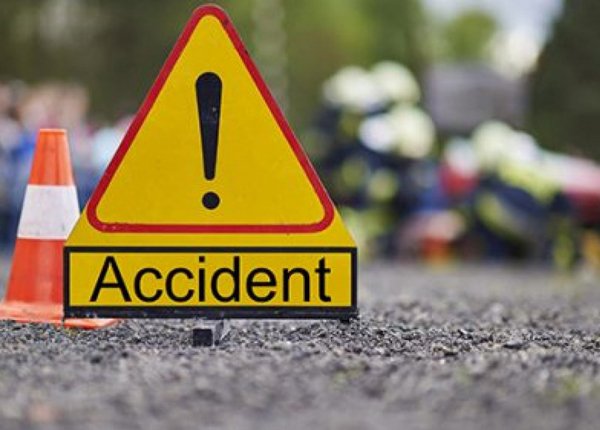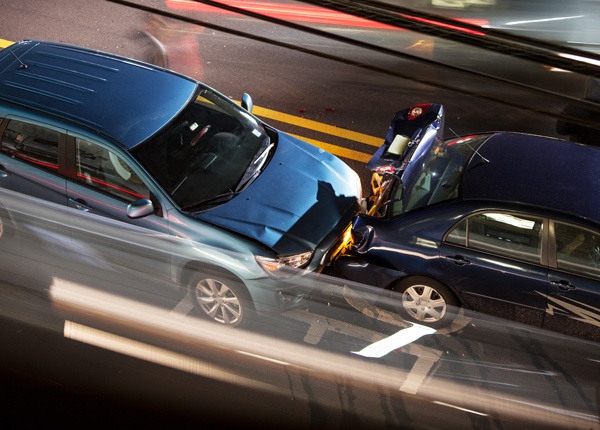
The Physics of Traffic Collisions & Accidents: Minimizing The Impact
Updated July 8, 2020The amount of damage sustained in a traffic collision is determined by the energy your vehicle has at the moment of impact, and the energy of the object you hit. It is important to understand the forces at work in collisions, as there is usually some action a driver can take to minimize the severity of a crash, if one is imminent.
Remember that your vehicle must lose all its kinetic energy to come to a complete stop. In a normal driving situation, gradual braking and slowing will allow time for this energy to be absorbed by the brakes. In an emergency when a moving vehicle comes to a sudden stop, its kinetic energy must dissipate instantaneously. If you stop suddenly by colliding with another vehicle or object, the amount of kinetic energy your car has left at that moment will determine the force of the impact. The greater the energy, the greater the severity of the crash.
The two factors which determine the energy of a moving vehicle are its weight (or more specifically, its mass) and the speed at which it is traveling. In simple terms, an object’s kinetic energy is equal to half its mass multiplied by the square of its speed. Heavier objects have more energy but in terms of crash severity, speed has a lot more to answer for.
The force of a collision
The force and subsequent severity of any collision depend on the energy your vehicle has at the moment of impact, and the energy held by the object you collide with. Newton’s second law states that any object you hit will exert force back onto your vehicle – even if it is stationary. As every action results in an equal and opposite reaction, your speed at the point of impact (and the weight of the object you hit) will determine how much force it exerts on your car. An object light enough to move when you hit it will absorb some of your kinetic energy, thus limiting the severity of the collision.
So, if you hit a very light object such as a trash can or a traffic cone, the vehicle’s force will far outweigh that of the object and the damage your car sustains should be minimal. In all likelihood, a trash can would simply bounce off your car leaving little more than a dent in its wake. Colliding with a heavier stationary object such as a parked car or a lamp post would be a very different story. If your force on impact is not sufficient to move the object, the force it sends back at your car will be significant and could do a great deal of damage.
Colliding with other vehicles
The total force of impact (FOI) in a collision between two vehicles is affected by the direction both cars are traveling in and the point at which they connect. If both vehicles are moving toward each other, their combined kinetic energy will contribute to the FOI and result in a more severe collision. This is why head-on collisions are so dangerous and frequently result in loss of life or serious injury.
When two cars collide head-on, the vehicle with less kinetic energy will take the most damage. This means a slower car will be affected more than a faster car, and a lighter car will be affected more than a heavier car. When there is a considerable disparity between the weight and/or speed of two colliding vehicles (for instance, when an articulated truck hits a small passenger vehicle) the lighter vehicle may be thrown backward or completely crushed.
Traffic collision severity
Let’s look at how force affects impact severity in different types of collisions.
Head-on collisions
Head-on collisions always produce the greatest force on impact. If you are traveling at 40mph and collide head-on with another vehicle also traveling at 40mph, the force of the impact will be equivalent to hitting a brick wall.
Side-on collisions
Side-impact collisions (also known as T-bone collisions) are the second most severe type of collision. As the two colliding vehicles are not moving directly toward each other, some of the FOI is reduced by forward motion.
Sideswipe
Collisions where two vehicles hit each other in a side-on, sideswipe motion are among the least severe. If you end up in a situation where you cannot avoid a crash, you should steer evasively to aim for a sideswipe rather than a T-bone or head-on collision.
Rear-end collisions
Rear-end collisions tend to have the least FOI. The force of the rear car is transferred into the front car upon impact, using up kinetic energy by moving it forward.
Minimizing the force of impact
There is almost always something that can be done to minimize the force of impact when a collision is unavoidable. You may only have a few seconds to assess the situation and react, but this should be plenty of time if you remain calm and remember your driver’s training. Here are some severity-reducing tactics which can help you to avoid serious injury in the event of an imminent collision:
- 1

Reduce your speed.
Remember that FOI is determined by energy, which is largely determined by speed. Anything you can do to decrease your speed on impact will lessen the severity of the incident. Use controlled braking to avoid skidding and if possible, steer in a way that gives you more time to lose speed before the collision. - 2

Hit something softer.
If you cannot slow down in time to avoid a collision altogether, you may be able to redirect your car towards an object that will result in less damage. Choose bushes, crash barriers and sand barrels over concrete barriers, buildings and other vehicles. - 3

Hit side-on rather than head-on.
If you are on track for a head-on collision with another vehicle, consider whether you can lessen the severity of the incident by steering to hit another vehicle side-on instead.
Vehicle safety systems
Today’s cars are designed with safety features to help lessen the severity of collisions and improve the vehicle’s overall performance. Some of these features – such as seat belts – are present in all vehicles, whereas other more advanced features are only available in certain makes and models. You should understand these features and how they work, in case you should ever drive a vehicle that utilizes them. This information will also be useful when you come to choosing a car for yourself.
ABS, ESP and traction control
It is quite common for modern vehicles to include electronic safety systems which help to maintain optimal balance and improve traction.
- 1

Antilock braking systems (ABS).
Antilock braking systems are designed to prevent wheel lock and loss of traction when braking. The driver need only press down firmly on the brake pedal, which will result in the brakes pulsing against the wheel to slow the vehicle gradually without causing wheel lock. - 2

Traction control systems.
Traction control systems use sensors on the vehicle’s wheels to detect when one or more wheels have lost traction and are rotating faster than the others. The system then automatically applies the brakes on that wheel, to slow it down until it regains traction. - 3

Electronic stability programs (ESP)
Electronic stability programs or active steering control systems are designed to minimize understeering and oversteering. These clever systems compare the movement of the steering wheel with the actual course and trajectory of the car. If it detects a disparity between the two, the system will strategically apply the brakes to help the driver stay in control of the vehicle.
There is no doubt that electronic safety systems can make it far easier to control a vehicle in poor driving conditions or during an emergency. However, just like the mechanical components of your car, these safety systems are susceptible to malfunctioning. All drivers must know how to maximize traction, restore balance and prevent understeer or oversteer without the aid of these systems as they may one day be forced to cope without them.
Seat belts
No matter how many high-tech vehicle safety systems are developed in the future, none will ever be able to reduce death and injury as effectively as the simple seat belt. This is the car’s ultimate safety feature, and yet, so many motorists neglect to buckle up before driving. Wearing your seat belt is the single most effective way to stay in control during emergency maneuvers and protect yourself during a collision.
If you are not wearing a seat belt, executing evasive maneuvers could throw you from the driver’s seat, making it harder to reach the steering wheel and pedals. Your seat belt will also ensure you are in a safe position if an impact causes the airbag to deploy. Without the seat belt holding you in place, the force of a deploying airbag could cause serious injury.
Know your owner’s manual
Most drivers have little more than a brief flick through their vehicle owner’s manual before tossing it into the glove compartment or on to the back seat. Familiarizing yourself with the contents of your owner’s manual is imperative, as it contains invaluable information about the vehicle’s safety features and electronic systems which could one day save your life in an emergency. Anything you need to know about in-car adjustments, tire pressure and alignment, weight distribution and dashboard controls will be detailed in this book – make sure you study it thoroughly!




